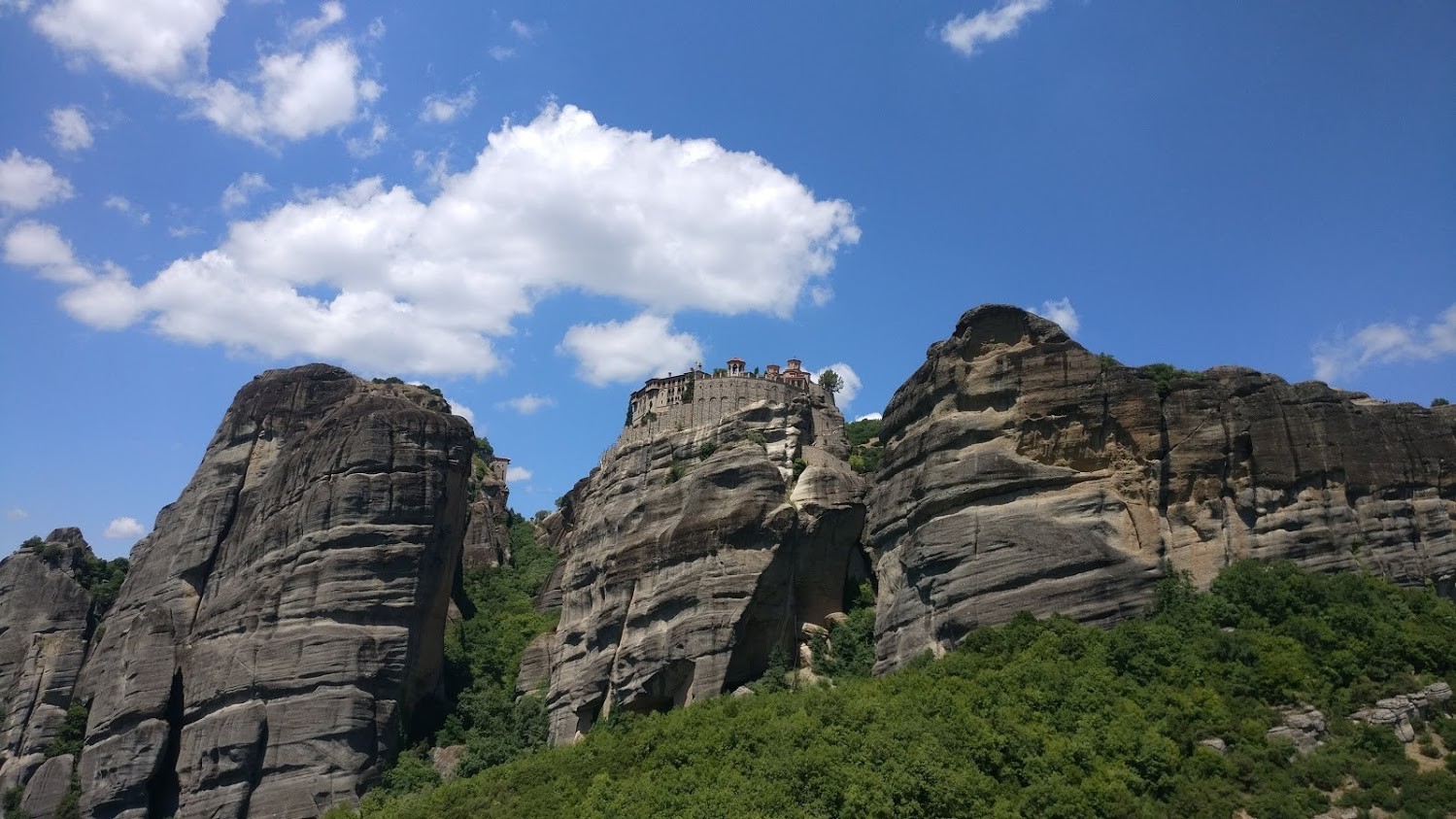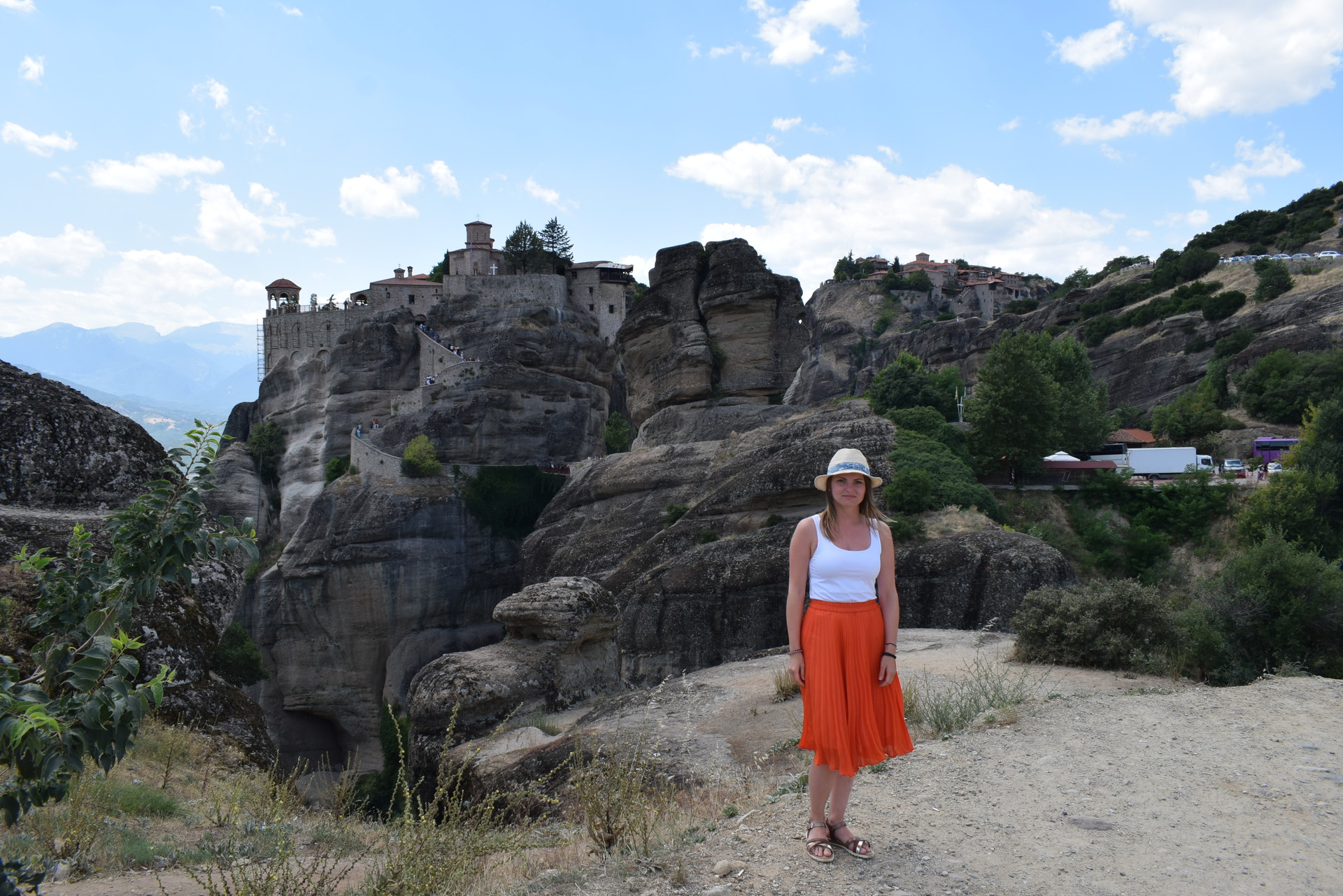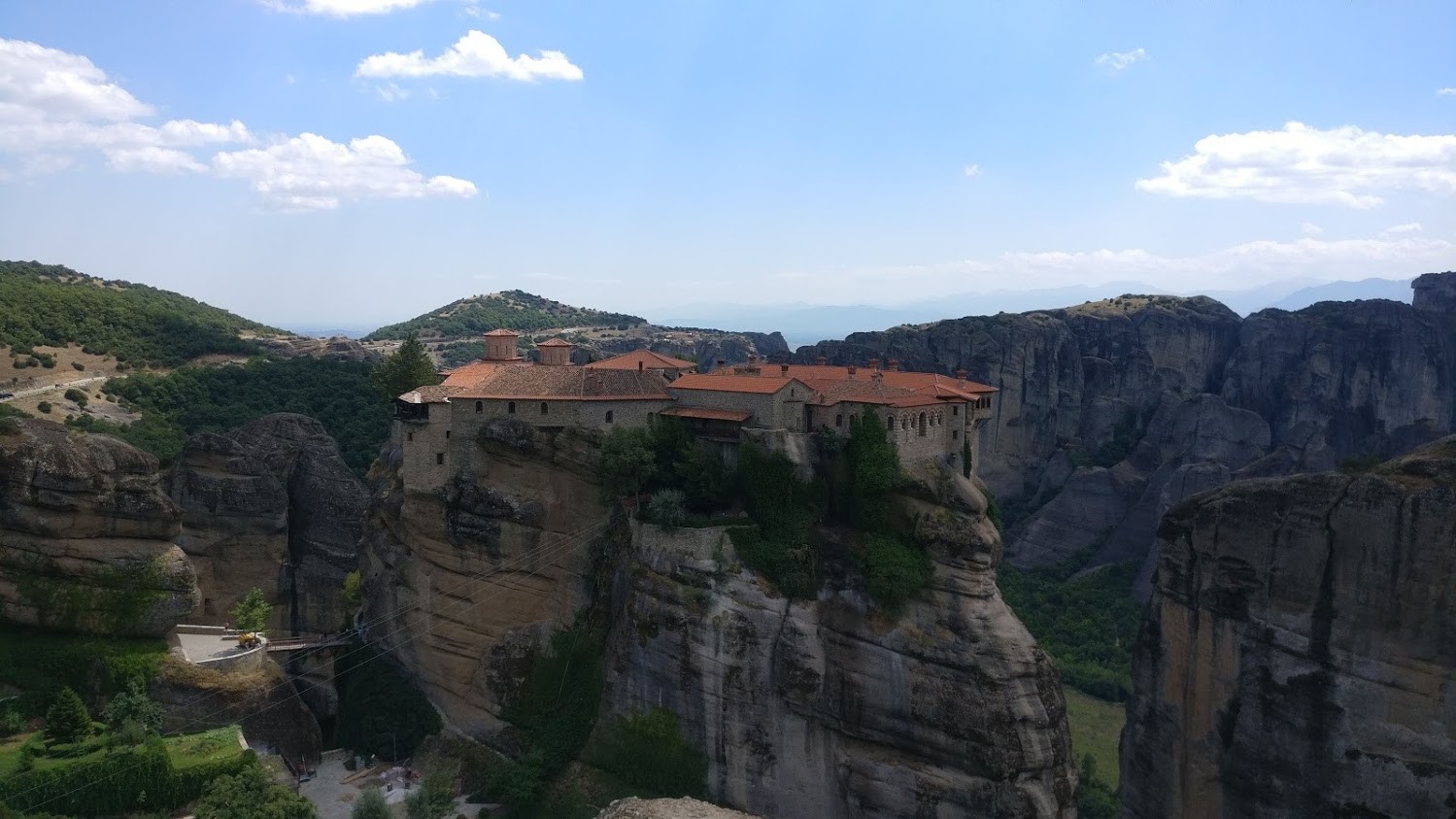A day trip to Meteora
I still remember approaching the city of Kalambaka and the view that was revealed in front of us, which was of the humongous stone pillars holding the ancient monasteries on top. This was the famous view of the Meteora, which was one of the most famous landmarks in Greece and I was beyond happy that I finally got the chance to visit it. Its name was reminding me of the word “meteor”, but instead, it meant “hovering in the air”, which was referring to the monasteries that were built on top of the high stone pillars that looked like they were almost about to reach the sky.
Meteora was created millions of years ago by lots of volcanic activity and earthquakes that led to the creation of the high stone pillars. Then, lots of streams started flowing through the valley separating the pillars, which led to the smoothening of the huge stones. However, at some point, the water dried out and there was only the ever-green valley left along with the high pillars.

Around the eleventh century, lots of monks started settling in the area and along with that, they started building the first monasteries on the tops of the stone pillars. With time there were a couple of monasteries built and especially during the Ottoman occupation, they were building the monasteries even higher so that they can’t be reached.
An interesting fact about the building of the monasteries is that the monks were using huge baskets and ropes full of rocks so that they can build the monasteries and later they used them to bring people up the monastery or food and water, so they can satisfy their needs. Nowadays, some of those baskets are still used by the monasteries, even though they are very well connected with each other via asphalt pathways.
The monasteries were highly worshipped by the Greek people because, during the Ottoman occupation, they were the place where their religion and culture were kept untouched. They were also the religious centers for the Greek people that were seeking salvation and even were places were lots of poets, painters and philosophers were gathering to create.
Meteora has gained its fame, due to the incredible landscapes and the monasteries that were built on the tops of the pillars. It is a truly amazing place to visit and is usually very busy, especially during the summer months. In addition to that, you have to plan your visit there very carefully, as all of the six working monasteries have different working hours and you have to comply with that too. Bear in mind, that you have to be dressed properly, as they do not allow people to go inside the monasteries with skirts, short shorts and tops where your arms would be visible. Also, in some of the monasteries, they might ask you to put some cloth around your hair, especially if you are a woman. That is why before going to the Meteora, we spend a lot of time planing very carefully our trip there, as we wanted to visit as much as possible on our day trip.
How to get to Meteora?
Meteora is located around three hours drive away from Thessaloniki with a car and almost the same time with either bus or train. In the beginning, we were considering to go by using the public transports and researched a lot on our option in Thessaloniki, but eventually, decided that it will be best to go there by car. This way it would be cheaper and more convenient for the four of us. However, I will share all the valuable information with you, as I believe that you might need it.

We have been travelling to Meteora and it took us around four or five hours, as we were coming from Sithonia peninsula. The highway to it was quite good and we did not have any issues, but we had to pay a fee to drive on it, so keep that in mind. Also, bear in mind that after the highway, the path to Meteora is quite difficult as there are lots of turns, but it is bearable. Once we arrived in Kalambaka we continued straight up the pillar and followed the GPS, which was a pretty good navigator, so we had no issues.
However, there is a way to go to Meteora by bus, which is quite easy and costs around twenty euros. You can catch a bus from the central bus station in Thessaloniki or almost any bigger city in Greece. However, the ticket should be with a final destination at Trikala from where you can catch another bus to Kalambaka, which is around five euros.
Last but not least, you can catch a train to Kalambaka from Thessaloniki’s main train station. While we were there, I asked at the ticket office, the ticket price is around eighteen euros, so it is almost the same price as the bus ticket, but it will bring you directly at Kalambaka. Thus, I think that if we didn’t have the option to go by car, we would have gone to Meteora by using the train.
What to visit in Meteora for a day?
When we arrived at Meteora it was almost eleven in the morning, so we did not have a lot of time to go everywhere. Thus, we quickly checked the working hours of each monastery in the complex and started our trip.
The Roussanou Monastery
Our first stop was the Roussanou Monastery, which was one of the first monasteries on the way up the hills. It was built in the middle of the sixteenth century and it could be easily reached from the stairway near the road. From there we had to climb for around twenty minutes until we reached its top. Luckily, the staircase was covered with a thick forest, which was hiding us from the burning sun, that was absolutely merciless.
Once we got up, we had to pay a fee of three euros and put on special aprons to cover the naked parts of our bodies. Then we entered into the small monastery, which was full of religious paintings and icons, along with a map of Meteora. It consisted of a very small room, but it was quite cosy and cool, so it was a pleasant experience. Next to that room, there was a shop from which one could buy various souvenirs, honey and wine that was produced in the valley. Close to it, was the terrace of the monastery, which was full of beautiful flowers, which only added to the mesmerizing view that was revealed of the Varlaam monastery that was on the other side.
When visiting the Roussanou Monastery, bear in mind that its working times are from 9 in the morning until 5 in the afternoon. Thus, there is plenty of time to visit it, compared to the working hours of some other monasteries.
The Varlaam Monastery
Right after visiting the Roussanou Monastery, we went straight to the Varlaam Monastery, which was the second-largest monastery in the complex. The working hours of the monastery were from 9 in the morning until 3 in the afternoon.

When we reached it, we had to climb its spiral stairway up to the entrance of the monastery. It was taking quite a while to get up, as there were many people visiting it at that point and also, at some point the pathway that was carved into the huge rock was so narrow that only one person could go through it.
However, we managed to go up there in around twenty minutes and at the entrance, we had to pay the same amount of three euros to enter. Right after the entrance, we went inside the monastery, which was indeed a big one, as it had a big church with lots of frescoes and icons hanged on the walls, a terrace with a fountain and a garden, a huge kitchen and lots of rooms showing how and where the monks were living and are still living in there. There is also a huge wooden barrel, which was used for storing water a couple of centuries ago.
As per the story, the Varlaam monastery was built by a monk named Varlaam in the middle of the fourteenth century. To build the monastery, he used the baskets and ropes to get the materials up to the hill. It took him and the other monks helping lots of time, but eventually, they managed to finish the monastery.

After visiting the Varlaam monastery, we stopped at the Meteora Observation Deck, where we could take a look at the valley and most of the monasteries in the complex. We parked the car and had to climb a little rocky hill to get the best view of the monasteries. From there we could see the Varlaam monastery, the Roussanou monastery, the Holy Trinity monastery and the Agios Stefanos Monastery. This view over all of the monasteries was truly incredible and a must-see for every visitor.
The Agios Stefanos Monastery
Finally, around 4 in the afternoon we headed to the Agios Stefanos Monastery, which was quite easy to reach by just crossing a bridge-like path to its entrance. Its working hours were from 9 in the morning until 1:30 and then from 3:30 until 5:30 in the afternoon. The ticket price was the same as for the other monasteries that we have already visited, so we had to pay it at the entrance. Here, I would like to mention that in that monastery, the personnel were the strictest about the clothing of the visitors and they were making lots of people to return because they were not properly dressed.
The Agios Stefanos monastery was built around the twelfth century and was not as big as Varlaam monastery, but was a very beautiful one. It had two churches of which one was quite damaged, but still well preserved. However, both of the churches were housing valuable frescoes and icons created by the monks living in the monastery. Inside we could also see ancient books from which the monks were reading at the liturgies that were held in the churches. Unfortunately, we did not have a lot of time to explore the monastery, as it was closing soon, so we had to leave quite quickly.

After visiting the Meteora, we were quite exhausted and headed to our next destination, where we have booked a place to stay for the night. Honestly, visiting the Meteora was one of the best trips I ever had. It was a truly beautiful and breathtaking place and only the thought of how much effort and dedication those people have put into building those monasteries makes me feel ecstatic. It was absolutely amazing!
Photo gallery
Content available in other languages
- Español: Viaje de un día a Meteora
Want to have your own Erasmus blog?
If you are experiencing living abroad, you're an avid traveller or want to promote the city where you live... create your own blog and share your adventures!
I want to create my Erasmus blog! →








Comments (0 comments)